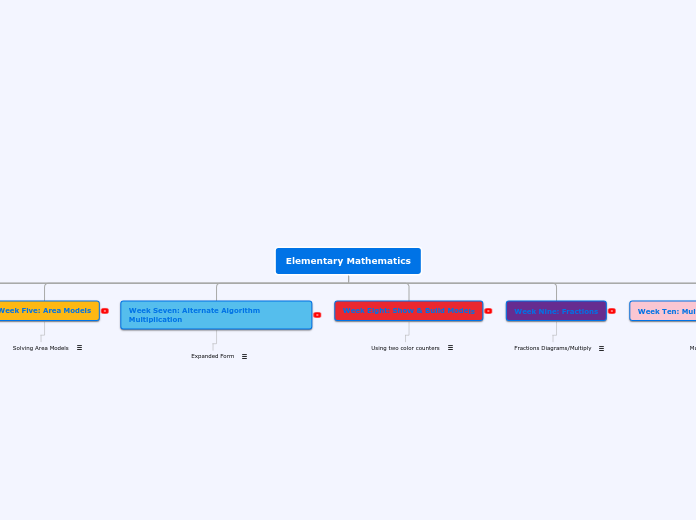
Diagrams
24 six : 6 + 6 + 4 = 16 Units------------- 6------------- 6-------- 473 eleven : 11 x 7 = 77 + 3 = 80 Units--------- 11--------- 11--------- 11--------- 11--------- 11--------- 11--------- 11----- 3
Land of Bases
EXAMPLE ONE 13 five l ...+31 five + lll .-------------- ----------44 five 44 fiveEXAMPLE TWO 10 three l+ 11 three l.----------------- ------------ 21 three 21 three
Algorithms
Draw diagrams of base ten blocks to convert each problem to the different basesConvert to base tenEXAMPLE 342 five3(5^2) + 4 (5^1) + 2(5^0)3 (25) + 4 (5) + 2 (5) 75 + 20 + 10 = 97
Solving Area Models
EXAMPLE (24) 28) 20 + 8 20 400 160 ---------------------------------- + 4 80 32 560 + 112 = 672
Expanded Form
EXAMPLE27(36) 20 + 7 x 30 + 6-------------- 600 + 210 + 120 + 42---------------- 720 + 252 = 972
Using two color counters
SHOW : 5 Using 9 Tiles (counters) * * * * * * * > > OR + + + + + + + - - (9 total tiles, 7 positive 2 negative, 7 - 2 = 5)
Fractions Diagrams/Multiply
2 (1/2) ----------> D D (two halves equal a whole -------> O 2/3 (1/6) --------> *answer should always be smaller* O take 2/3 of the whole ---------> 1/6
Multiplying Fractions
(3 3/4) (2 4/5)3/4 x 4/5 = 3 x 4 12 3 -------- ---------- ----------> ----- 4 x 5 20 5
RULES
2: Even numbers3: sum of digits is divisible by 3 4: last two digits are divisible by 4 (example: 512) 5: any number ending in a 5 or 0 6: must be an even number and sum of digits must be divisible by 3 (example: 322) 8: last three digits are divisible by 8 9: sum of digits is divisible by 910: any number ending in zero
PEMDAS IN INEFFICIENT
PEMDAS = NOT VERY EFFECTIVE CONFUSES STUDENTSNEW WAY: LEVEL ONE: P ---> Parenthesis LEVEL TWO: E ----> ExponentsLEVEL THREE: d/m ---> divide/multiply, same level, do them at the same timeLEVEL FOUR: s/a ---> subtract/add, same level do at the same timewhen students questions which comes first for (s/a, d/m) explain to them that it goes left to right